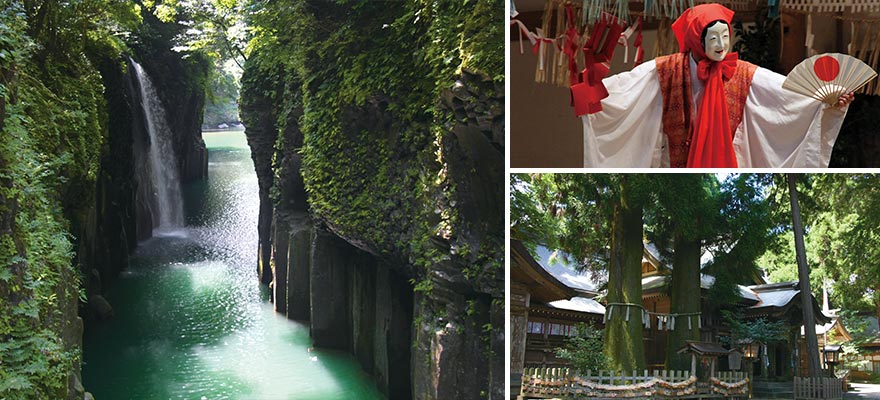Home > Highlighting JAPAN >Highlighting Japan April 2014> 47 Prefectures from A to Y
Highlighting JAPAN
47 Prefectures from A to Y
Miyazaki
Visiting the cradle of Japan

Miyazaki is a largely mountainous prefecture occupying much of Kyushu's eastern coastline. Palm trees in the south are distinctive of the area's subtropical climate, which has helped make it a popular domestic travel destination. Most importantly, however, Miyazaki occupies a special place in Japanese history for a mountain town called Takachiho. For it was here the deity Ninigi-no-Mikoto, grandson of the sun goddess Amaterasu, is said to have descended to Earth.
With some 1.3 million tourists per year, Takachiho is Miyazaki's most-frequented sightseeing spot. A visit to Takachiho Shrine is an excellent way to become familiar with the legends that swirl around this region like the early-morning mountain mist. The steps leading up to the cedar-enveloped shrine are not straight but diagonal, which Ayu Yano of the town's tourism and planning department explains is out of respect to the deities enshrined there, as the angle enables visitors to avoid presenting their backsides to the gods upon leaving. Two cedar trees on the shrine's grounds have been bound together with a shimenawa sacred Shinto straw rope, and it's said a couple can strengthen their relationship by walking hand-in-hand around the trees three times.
Takachiho is famous for its yokagura dance. The dance has no less than 33 parts and starts late in the afternoon, extending well into the following morning. Performers don large masks and, accompanied by traditional Japanese instruments such as flutes and drums, reenact such scenes as the time Amaterasu hid herself in the nearby Amanoiwato cave, depriving the world of light and leading the other gods to make varied attempts to lure her out. This full performance is held annually from November to February to give thanks for the year's harvest, but an hour-long glimpse of the dance can be seen every night at 8 p.m. in a performance hall at Takachiho Shrine.
Amaterasu's sacred cave can be found by Amanoiwato Shrine, a few kilometers northeast of Takachiho Shrine. While visitors cannot enter or photograph the cave itself, priests at the shrine, whose main buildings are located facing it across the Iwato River, can escort visitors to a vantage point and explain its significance in Japanese. A ten-minute walk from there leads to another cave along the river where the gods are said to have deliberated ways to persuade Amaterasu to leave her retreat. This cave includes the small Amano Yasukawara Shrine, replete with little towers of stacked stones representing the wishes and prayer requests of previous visitors.
Heading back to the south of the town, the blue-green waters of the Gokase River flow through the picturesque Takachiho Gorge. Formed by lava flowing from nearby Mount Aso an estimated 90,000 to 120,000 years ago, water has worn down the rock to create dramatic cliff walls. These are best experienced from a rented rowboat, which allows one to appreciate the unique rock formations and the 17-meter Manai Falls, listed among the One Hundred Waterfalls of Japan compiled by the Japanese Ministry of the Environment in 1991. Japanese maples and other native trees extend a leafy canopy over the gorge, said to be particularly beautiful when the leaves turn vivid red and orange in the fall.
Clean mountain air and gorgeous scenery are reasons enough to visit Takachiho, but Yano notes perhaps the best reason of all: "This is said to be the place where Japan was born," she says. If you haven't visited, it's time to go!
© 2009 Cabinet Office, Government of Japan






